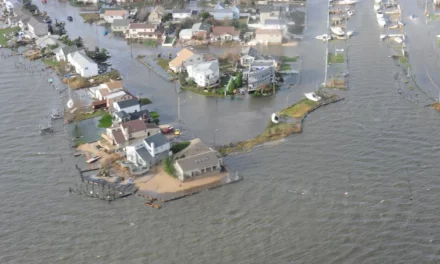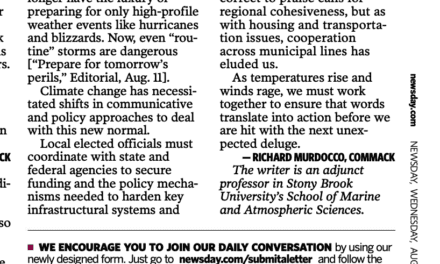The following a sponsored post written by an advertiser. For more information on the separation between sponsored content and The Foggiest Idea’s reported work and data-driven analysis, click here.
By Paul J. Napoli
In a last-ditch effort to prevent a huge toxic plume from threatening even more New York residents, Governor Andrew Cuomo said the state will spend $150 million to build a system of wells and treatment facilities south of Bethpage.
Beginning in the 1930s, the United States Navy and defense contractor Northrop Grumman conducted various aircraft and other tests involving radioactive material on a 600-acre site near Bethpage, New York. Even after the Environmental Protection Agency declared the area a hazardous waste site in 1983, these experiments continued for about a decade. As a result, a toxic plume engulfed the groundwater.
Researchers now estimate that this plume is almost two miles wide, four miles long, and 800 feet deep. These scientists estimate that in the next twenty years, the southward moving toxic plume will poison water supplies in South Farmingdale, Massapequa, and Levittown, and then move out to the Atlantic Ocean.
The ambitious plan is designed “to pull out as much contamination as possible,” according to New York State Department of Environmental Conservation Deputy Commissioner Martin Brand. One four-well network directly over the toxic cloud would remove the tainted groundwater and replace it with drinkable water. Fourteen other wells around the cloud’s perimeter would keep it in place. The system, which would treat up to 30 million gallons of water per day, should be online between 2021 and 2023.
“Delay is an enemy, and time is of the essence,” Governor Cuomo remarked. “And every day we lose, that plume moves. And that plume is now affecting more homes,” he added.
What’s In The Cloud?
Among various other hazardous elements, the Bethpage cloud contains radium. This dangerous element occurs naturally. Except in very high exposure cases, the ill health effects are usually mild to moderate and dissipate once the person is no longer exposed to radium.
1,4-Dioxane, however, is another story. Since about 1980, the Food and Drug Administration has urged chemical companies to stop using this dangerous artificial substance that’s widely used in both industrial and personal care products. 1,4-Dioxane stabilizes aluminum during transportation, so it’s widely used in aircraft and other such machines. This chemical is also a rather powerful solvent that’s a key ingredient in many detergents, shampoos, and other items.
Groundwater 1,4-Dioxane contamination is a particularly acute problem. This chemical diffuses in water, does not bind to the soil, and is not biodegradable. As a result, levels of up to 11,000 parts per billion, which is almost 100 times the level that the Environmental Protection Agency considers safe, have been found in many contaminated sites throughout the Northeast.
Short-term exposure causes painful chemical burns in the nose and throat. Long-term exposure causes liver and kidney disease. Moreover, the International Agency for Research on Cancer classifies the chemical as a possible carcinogen. Researchers have shown that the chemical, mostly the vapors, causes cancer in laboratory animals. The State of California also classifies 1,4 dioxane as carcinogenic under Proposition 65.
Until the 1950s, engine maintenance personnel commonly used trichloroethylene (TCE) as a degreaser. This dangerous chemical is also in the Bethpage cloud in very high amounts. Its original British manufacturers touted TCE as a safer alternative to chloroform and ether. But serious health effects soon became apparent, including:
● Irregular heartbeat,
● Fetal demise, and
● Cancer.
In 2005, the EPA added TCE to the list of known human carcinogens.
Legal Remedies Available
To obtain compensation for both individual victims and the governments that must spend taxpayer dollars cleaning up these environmental messes, attorneys often turn to the public nuisance doctrine. This common-law rule has various elements in different jurisdictions, but generally, victims must establish that:
● The defendant’s failure to act caused a public health problem,
● Many people were affected at about the same time,
● The seriousness of the harm outweighs the social utility, and
● The defendant’s misconduct substantially caused the victim’s damages.
The third and fourth prongs are often the most difficult ones to establish. But note that the harm/utility element requires a balancing. As long as there is a little more harm than social utility, the victim usually prevails on this element. Also note that the defendant’s conduct must not be the only cause, but rather a substantial cause. There is a significant difference.
Many groundwater poisoning diseases do not appear for several decades. But under the discovery rule, the statute of limitations does not begin to run until after the victim knows about the injury and has a reason to connect that injury to the defendant’s misconduct. Since many chemical companies do their best to cover up the damages that their products cause, that time period could be several decades or even longer.
Groundwater poisoning is a serious nationwide problem and many victims must turn to the legal system to obtain the compensation and justice they deserve. For a free consultation with an experienced personal injury attorney in New York, contact Napoli Shkolnik PLLC. There is no upfront legal fee in these matters.
About the author:
Paul J. Napoli is a nationally renowned personal injury, medical malpractice, and mass tort litigation attorney with more than 25 years’ experience in the field. Along with his wife Marie Kaiser Napoli, he aggressively defends the rights of his clients in courtrooms throughout the country, fighting to ensure they get the maximum amount of compensation they deserve. Trusted by those he represents and respected by his colleagues in the legal field, he has a well-earned reputation for integrity and honesty, and a dedication to ensuring justice is served.














